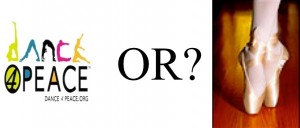 A recent ARTSblog post Civic Engagement in the Arts in Action-Part I (thanks Maya Kumazawa) brought to mind a topic that needs to be addressed. The post featured an interesting organization called Dance 4 Peace. (I love it when a group nails its mission with its name. It’s hard not to understand what D4P is about–”Dancing to inspire cultures of peace”–even if the methods need explaining.) Their website says that “Dance 4 Peace is a conflict resolution, civic education program that promotes empathy, understanding, mediation skills, anger management, emotional and civic engagement through dance in youth around the world.” One can fairly surmise, even without reading the history of the organization and the bio of the founder, that a dancer was bitten by a passion for promoting peace and has chosen to pursue that passion via her art form. (Yes, I’m on an alliterative roll.) The organization is, then, one that makes use of the arts to make the world a better place.
A recent ARTSblog post Civic Engagement in the Arts in Action-Part I (thanks Maya Kumazawa) brought to mind a topic that needs to be addressed. The post featured an interesting organization called Dance 4 Peace. (I love it when a group nails its mission with its name. It’s hard not to understand what D4P is about–”Dancing to inspire cultures of peace”–even if the methods need explaining.) Their website says that “Dance 4 Peace is a conflict resolution, civic education program that promotes empathy, understanding, mediation skills, anger management, emotional and civic engagement through dance in youth around the world.” One can fairly surmise, even without reading the history of the organization and the bio of the founder, that a dancer was bitten by a passion for promoting peace and has chosen to pursue that passion via her art form. (Yes, I’m on an alliterative roll.) The organization is, then, one that makes use of the arts to make the world a better place.
There are many such efforts and their number is growing rapidly. This is a trend that I give a standing ovation. The more examples like this that people see, the more they will understand that the arts are not just good for a few “thems” in elegant concert halls or museums but that they have much to offer a very large “us.” The potentially unfortunate part is that individual artists and arts organizations with specifically arts-centered missions (and these are and should be the vast majority of the field) may see these examples and conclude that awareness of the world outside the auditorium or gallery may be good (even laudable) for those so inclined, but that is not what they’re about and, therefore, they need not concern themselves with thoughts about the community.
This binary thinking (either/or) is both understandable given the history of the field and unfortunate. I argue (incessantly) that engagement is important for practical reasons–e.g., fundraising, marketing, public policy. (I also believe that it’s important for ethical reasons but I won’t go down that path here.) It is possible for arts organizations to include engagement in planning without becoming social service agencies. In my fevered brain, the ideal model is one in which engagement is the umbrella covering all aspects of an arts organization’s activities: programming, development, etc. And it is through the activities arising from that mindset that the world is made a better place. Ah, Nirvana. But at the very least, engagement should infiltrate its way into the thinking of some subset of the whole. So, everyone out there,
Engage!
Doug
Ballet slippers (with feet): ![]()
![]()
![]() Some rights reserved by ♥ Unlimited
Some rights reserved by ♥ Unlimited
Dance 4 Peace Logo from website: Dance 4 Peace

Arts organizations too often act as if their mission is to bring attention to arts and artists. I think their mission should be to put the power of art forms in the service of the community. Instead of spending quite so much time figuring out how to get money and attention and audience, organizations might consider the needs of the surrounding community and try to understand which of those needs might be addressed by the organization’s particular artistic resources.
This won’t be a simple assessment; experimentation will be needed, and if the work is honest some of the experiments will fail. But when artists stop trying to impress others in the arts and instead start working on what their most wonderful art offers to regular civilians, both the work and the community may benefit. The way to evaluate the work would be to assess its effects on human beings and on community.
This means that the work of artists is entirely about engagement. It’s not that engagement is an ancillary activity, or some part of an organization’s work. Engagement is the whole enchilada.
I think it is fairly clear that I agree utterly with the essence of your statement. My only area of difference may be in tone. As I’ve said before, I’m not willing to beat up on either artists or the arts establishment for doing what they have been trained to do and rewarded (at least until relatively recently) for doing. If change is to occur, and I believe it can or I wouldn’t be bothering, I believe it will come through example and persuasion. . . . But I could be wrong.
Good point, Doug. Thank you. I sounded harsher than I meant to. Organizations and people, myself included, act according to our training and according to existing rewards and incentives. That’s a very important point. And it’s hard to do things differently without having people to imitate. That’s why innovation is so difficult, even when the need for it is obvious. Good examples will be tremendously helpful.